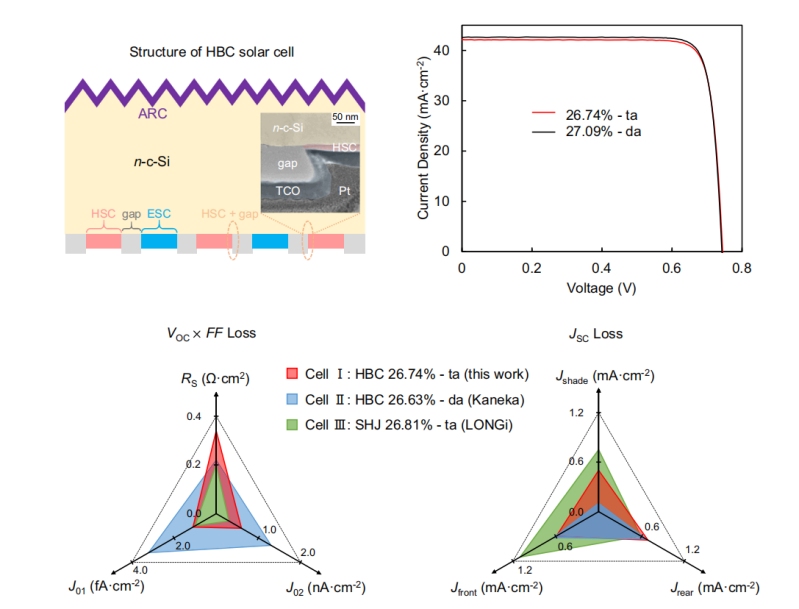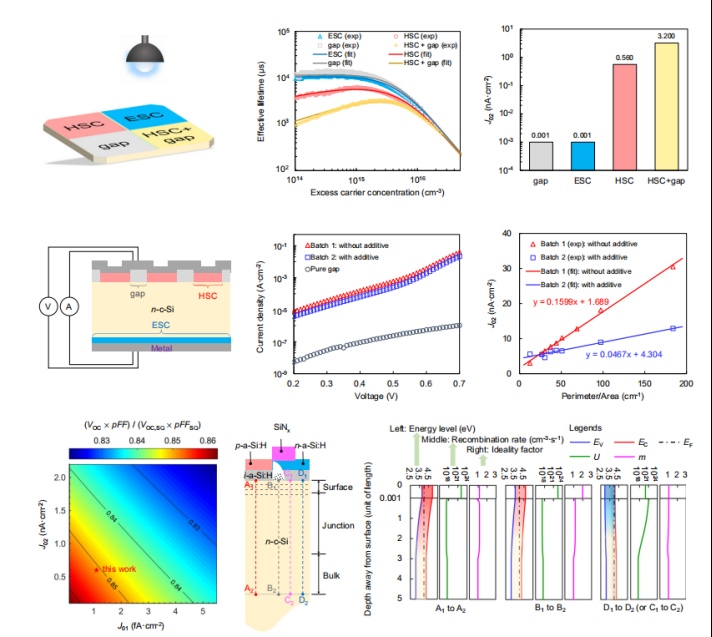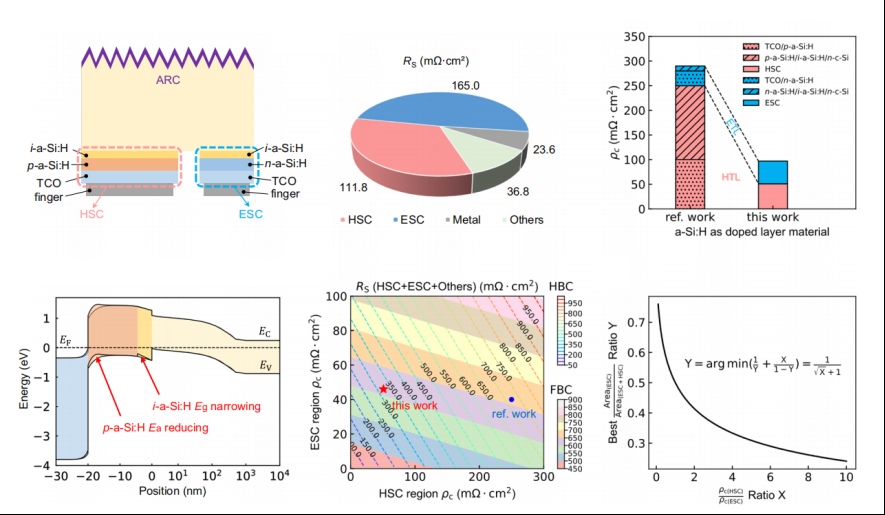The development of BC cells has reduced the cost of photovoltaic power generation, but the diversification of application scenarios has put forward higher requirements for solar cell technology. Studies have found that the contact resistivity of HBC solar cells has a great influence on cell performance. For example, high contact resistivity will lead to higher series resistance, which will reduce the fill factor and power conversion efficiency of the solar cell.
High-efficiency HBC solar cells

HBC cell structure diagram, J-V curve, electrical loss analysis, JSC loss analysis
By optimizing the cell structure and manufacturing process, the performance of HBC solar cells can be significantly improved. In particular, by reducing recombination losses and resistive losses, higher voltages (VOC) and fill factors (FF) can be achieved, thereby improving overall efficiency. In addition, by optimizing the anti-reflective coating on the front surface and the reflector on the back surface, the short-circuit current density (JSC) of the cell can be further increased and the efficiency can be further improved.
 By comparing the parameters of different types of solar cells (HBC and SHJ) at different areas, we can see the impact of different structures and processes on cell performance. For example, in terms of open circuit voltage, different cells are different due to differences in materials and structures; short circuit current density is affected by factors such as silicon wafer thickness and measurement area; fill factor and power conversion efficiency comprehensively reflect the overall performance of the cell.
By comparing the parameters of different types of solar cells (HBC and SHJ) at different areas, we can see the impact of different structures and processes on cell performance. For example, in terms of open circuit voltage, different cells are different due to differences in materials and structures; short circuit current density is affected by factors such as silicon wafer thickness and measurement area; fill factor and power conversion efficiency comprehensively reflect the overall performance of the cell.
Composite properties of HBC solar cells

Crystalline silicon is laser patterned into four regions, namely HSC (hole selective contact), ESC (electron selective contact), gap, and HSC + gap. By comparing the lifetime curves of different regions, the differences in the recombination characteristics of each region can be clearly seen. This difference provides a basis for further analysis of the contribution of recombination current density in different regions, helps to determine which regions are the main source of recombination, and thus provides direction for optimizing cell structure and process.
By analyzing the energy band diagrams, recombination rates, and ideal factors of different regions, we can deeply understand the recombination mechanisms of different regions. This helps to take targeted measures to suppress recombination, such as suppressing recombination by enhancing the built-in electric field in the HSC region and reducing recombination by managing the boundary morphology in the polar boundary region.
Contact Evaluation and Design for HBC Solar Cells

The composition of the series resistor (RS) is:
Shows the composition of series resistance in HBC solar cells, including losses from HSC (hole selective contact) stacks, ESC (electron selective contact) stacks, metal resistance losses (from fingers to busbars), and other loss sources such as bulk resistance ). The sum of these resistive losses has a significant impact on cell performance at the cell's maximum power point (MPP).
HSC and ESC area contact resistivity optimization analysis:
Contact resistivity measurement: The TLM measurement method is used to extract the contact resistivity of HSC based on p-a-Si:H and ESC based on n-a-Si:H. The results show that the contact resistivity of HSC is 51.3mΩ·cm2 and that of ESC is 46.1mΩ·cm2. By optimizing the amorphous silicon (a-Si:H) layer and the doped nanocrystalline silicon (nc-Si(Ox):H) layer, the contact resistivity can be reduced, thereby reducing resistance losses.
In HBC solar cell design, contact resistivity and structural design are important to cell performance. By optimizing the contact area and adjusting the coverage area ratio of HSC to ESC, the series resistance can be significantly reduced, thereby improving the cell efficiency and fill factor.
Detection and analysis of current loss in HBC solar cells

External Quantum Efficiency (EQE): The EQE curve of da is higher than ta at all wavelengths, indicating that the JSC loss does not come from the optical channel but from recombination.
Simulation of electrical shading phenomenon: Under different surface recombination rates (SESC, gap), the IQE of the HSC region is close to 100%, while the IQE of the ESC and gap regions is lower, because the minority carriers need a longer transmission distance to reach the collection region.
LBIC measurement: shows a uniform decrease in LBIC intensity from the HSC region to the edge of the cell.
Recombination current density as a function of effective lifetime and transmission length: The model illustrates the transmission of photogenerated carriers (Jgen) in the device from right to left, where they are effectively collected (JSC) or recombined on the path (Jrec).
The sources of JSC losses in HBC solar cells are analyzed in detail through EQE spectra, LBIC measurements and simulation results, especially the electrical shading effect caused by the longer transmission length of minority carriers in the ESC and gap regions. The analysis results are of great significance for optimizing cell structure design, reducing recombination losses and improving cell performance.
Strategies for improving the photoelectric performance of HBC solar cells

Electrical performance optimization:
By comparing these parameters across different batteries, potential ways to improve cell performance can be identified, such as increasing the open circuit voltage (VOC) and fill factor (FF) by reducing surface recombination current density (J01 and J02) and series resistance (RS) ).
Optical performance optimization:
These parameters represent front surface reflection and parasitic absorption losses, back surface parasitic absorption and escape reflection losses, and electrical shielding losses, respectively. By optimizing these parameters, the short-circuit current density (JSC) of the solar cell can be increased, thereby improving the overall photoelectric conversion efficiency.
Through research and analysis, the researchers achieved the core optimization direction in the process of preparing HBC solar cells and achieved a high photoelectric conversion efficiency of 27.09%. In high-efficiency HBC solar cells, contact resistivity plays a key role, mainly due to the significant reduction of the contact area in the HSC or ESC region. By optimizing the HSC area, the researchers achieved the lowest contact resistivity below 55 mΩ·cm².